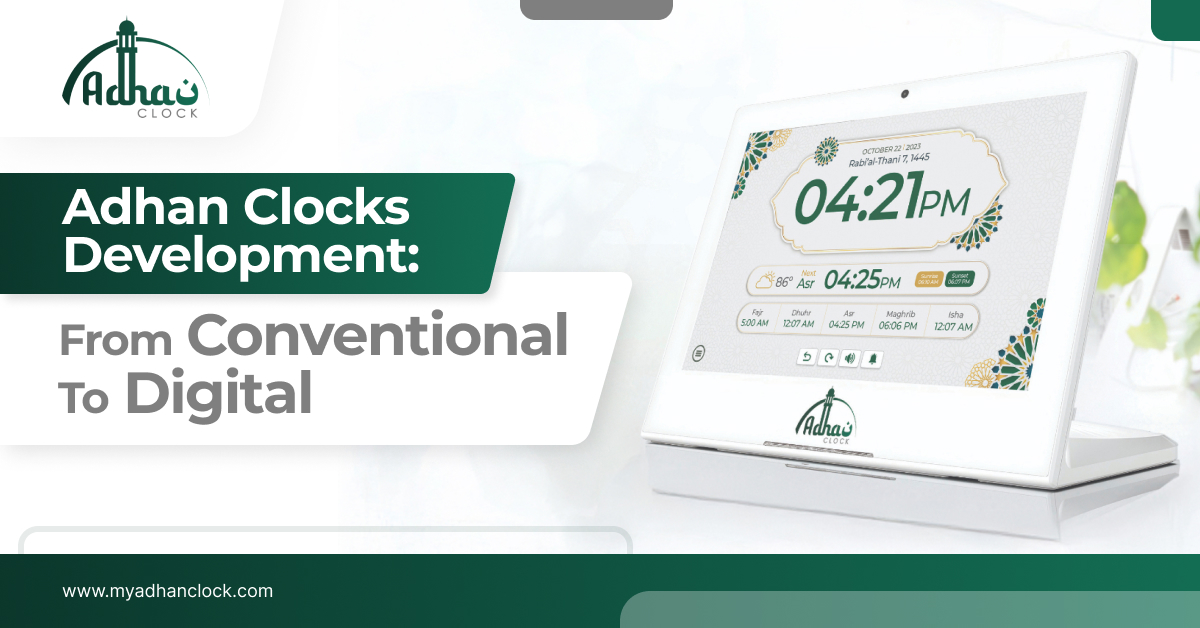Have you ever heard the adhan—the Islamic call to prayer? It’s a beautiful and meaningful sound that echoes through cities and towns worldwide, calling Muslims to pause, reflect, and connect with God throughout the day.
In today’s fast-moving world, finding those quiet, reflective moments can be challenging for anyone. That’s why adhan clocks, also known as azan or Islamic prayer clocks, have become such a helpful tool. They serve as gentle daily reminders, helping people maintain a spiritual rhythm—even during busy routines.
Even if you’re not Muslim, it’s interesting to think about: What helps you pause and relax during your day? Do you have your own version of a “spiritual clock” that reminds you to slow down and be present?
There is more to these clocks than merely keeping time. Many incorporate features such as the Hijri calendar, which is based on the Islamic lunar cycle, and Qibla direction indications to assist users in facing the Kaaba in Mecca during prayer. They are designed to complement a long-standing tradition while blending seamlessly with contemporary residences.
This blog will examine the evolution of Adhan clocks from their early analog versions to the sleek, modern digital ones. Whether you are considering purchasing these clocks or are simply interested in them, this article aims to help you better understand how they elegantly combine faith with technology.
The Origins of Timekeeping in Islamic History
Before modern clocks, tracking prayer times was a collective effort. The muazzin, whose melodic call indicated the beginning of worship times, was vital to mosques. Sundials and clepsydras (water clocks) were among the earliest instruments used to track time throughout the day. To align spiritual pursuits with the rhythms of nature, medieval Islamic scholars and others developed sophisticated timekeeping devices, including intricate water clocks equipped with gear trains.
Often led by individuals like the muwaqqit (mosque astronomers responsible for timekeeping from the late 13th century), these early innovations laid the foundation for what we now recognize as the adhan clock, striking a balance between religious devotion and scientific innovation.
The Emergence of Traditional Adhan Clocks
A Leap into Mechanical Precision
The demand for precise timekeeping increased as Islamic communities expanded during the late medieval era. By the 14th century, mechanical clocks with gears and weights had become prevalent in the Islamic world, possibly serving as reminders for prayer times. These classic adhan clocks were designed to accompany the muazzin’s call, providing a consistent method to monitor prayer times at home.
Key Features of Traditional Adhan Clocks
- For timekeeping, applied gears, weights, or balancing wheels.
- Alongside the loud adhan, analog devices featured visual time indications.
- Aimed primarily at providing the call to prayer.
This invention connected community-based prayer calls with personal spiritual dedication, bridging a significant gap in the development of personal prayer instruments.
Transition to Digital Adhan Clocks
Embracing the Digital Revolution
The digital age transformed adhan clocks into versatile devices. Digital technology introduced significant improvements, making these clocks indispensable for modern Muslims:
- Precision and Accuracy: Automatic updates contingent upon your location guarantee precise prayer times.
- Improved functionality includes features such as alarms for Fajr (pre-dawn prayer), volume adjustment, and multiple adhan voice options.
- Smart home systems and mobile app integration offer remote control and customization, improving consumer ease.
For tech-savvy consumers seeking dependability and convenience, digital adhan clocks have become appealing as a result of this shift.
Features of Modern Digital Adhan Clocks
Modern digital adhan clocks are smart devices meant to be effortlessly incorporated into daily living. Important qualities are:
- Updates on automatic prayer times: Real-time location-based changes taking into account seasonal fluctuation and daylight saving time.
- When praying, the Qibla Direction Indicator offers precise guidance for facing Mecca.
- The Integrated Hijri Calendar keeps track of Islamic lunar dates for religious observances.
- Multiple alarms, including a special Fajr wake-up call, are available with customizable alarm settings.
- Adhan Voice Options: Real call-to-prayer voices for a customized encounter.
- Integration of Smart Homes: Interoperability with Google Home and Alexa gadgets.
- Solar-Powered Options: Sustainable use with environmentally friendly designs.
These features combine timekeeping with advanced technology, ensuring timely and meaningful prayer experiences.
The Impact on Daily Life
Enhancing Spiritual Routines with Technology
Digital adhan clocks simplify and enrich spiritual practices, especially for Muslims in diverse settings.
- Simplify Prayer Times: Automatic updates guarantee correctness by eliminating the need for human revisions.
- Reliable reminders aid families, children, and the elderly.
- These clocks allow Muslims in non-Muslim nations to keep connected to their heritage and values. For example, a home in a Western metropolis with no nearby mosques can rely on its adhan clock to provide constant prayer hours.
- Boost Flexibility: Adjustable settings cater to diverse home requirements.
These advantages render digital adhan clocks crucial for preserving a regular spiritual practice.
What’s Next? The Future of Adhan Clocks
The Road Ahead for Islamic Prayer Technology
Adhan Clocks Change with Modern Innovations. As technology develops, Adhan clocks are set to undergo interesting changes beyond just telling time.
- Future models are expected to operate flawlessly with systems like Google Home and Alexa, providing a more connected and comfortable experience.
- Wearable Compatibility: Adhan reminders could soon be integrated into wearable devices, combining spiritual practices with health and lifestyle aspects as smartwatches become more prevalent.
- Upcoming designs might adjust to user behavior rather than one-size-fits-all notifications, providing reminders that meet their daily routines and preferences.
- Eco-conscious choices like solar-powered Adhan clocks could become increasingly prevalent, making them useful and environmentally friendly.
These developments, which mix tradition with contemporary technology, seek to preserve Adhan’s relevant and significant clocks for Muslims worldwide.
Conclusion
The move from mechanical to digital Adhan clocks shows how tradition and technology can come together beautifully. While modern features make life more convenient, these clocks still honor the spiritual essence of the call to prayer. Whether you prefer a classic Muslim alarm clock or a sleek digital one with innovative features, the progress in this space is truly impressive.
Buying a modern digital adhan clock is a way to welcome invention and legacy. Discover the latest adhan clocks to enhance your prayer practice and explore how technology can deepen your spiritual connection.
Frequently Asked Questions (FAQs)
What is an adhan clock?
An adhan clock, also known as an azan clock or an Islamic prayer clock, utilizes an auditory call, or adhan, to notify Muslims of the five daily prayer times.
How do digital adhan clocks change prayer times?
They automatically adjust prayer times based on the user’s geographic location, utilizing location-based algorithms that account for seasonal variations and daylight saving time.
Do Smart Home Devices Work with Digital Adhan Clocks?
Yes, they sure can. Many of the newer digital adhan clocks are built to work with apps and can even connect to smart home systems like Alexa or Google Assistant.
If you’re used to the old-style clocks and thinking about upgrading, it’s probably worth it. The timing’s more precise, setting it up is pretty straightforward, and it’s way more convenient when you can control everything from your phone or just say a command out loud. It’s a simple way to incorporate a bit of modern tech into your routine without overcomplicating anything—and still stay on track with prayer times.







